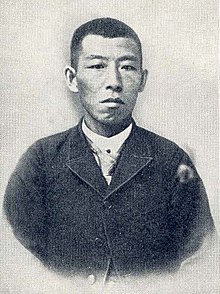Inō Kanori
Inō Kanori | |
|---|---|
 | |
| Born | June 11, 1863 |
| Died | September 30, 1925 (aged 62) |
| Occupation | Anthropologist |
Inō Kanori (伊能 嘉矩, 11 June 1867 – 30 September 1925) was a Japanese
Biography
Inō was born in Shinyashiki (新屋敷), Yokota Village (橫田村), Tono City (遠野市),what is now part of the city of
In The Island of Formosa (1903), former US Consul to Formosa
Inō returned to his native Tōno in 1905 and pursued cultural and folklore studies there, together with
Contributions to Taiwan’s historiography
Since Inō Kanori conducted the "survey on the preparation of educational facilities for aborigines," he had published several important and general articles on knowledge of Taiwan’s aborigines. In 1900, when Taiwan Customs Study Group (臺灣慣習研究會) was founded, Inō Kanori often published articles relating to old customs and folklore of Han Chinese in Taiwan on Articles on Taiwan Customs (《臺灣慣習記事》), marking his entrance into the realm of history from anthropology. In 1902, he published his first major work since he arrived in Taiwan: Chronicles of Taiwan (《臺灣志》). In 1908, he participated in the editorial work of Preface to the Greater Japan Dictionary of Geographical Names-Chapter of Taiwan. In 1922, when the Government-General established the Government-General of Taiwan Historical Materials Editorial Committee, Inō Kanori was hired as a committee member and compiled articles. When he passed away in 1925, he left a posthumous manuscript of The Complete History of Taiwan (《臺灣全史》) with as many as 54 volumes, which was published as Chronicles of Taiwan Culture (《臺灣文化志》) in 1928, and the renowned Japanese intellectual Ozaki Hotsuma who was in Taiwan praised Inō as "the authority of Taiwan’s historiography.” In the same year, most of Inō Kanori’s Taiwanese ethological specimens became part of
Bibliography
- Kanori Ino (2012). 平埔族調查旅行: 伊能嘉矩<台灣通信>選集 [Research trips among the Plains Aborigines: Selections from Inō Kanori's Taiwan diaries] (in Chinese). Translated by ISBN 9789573268932.
